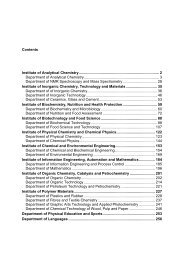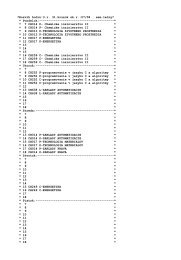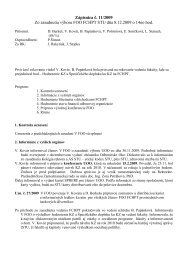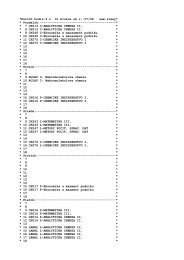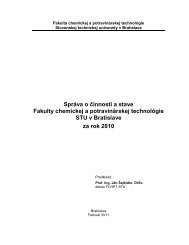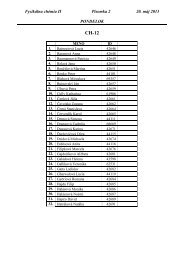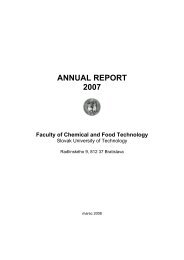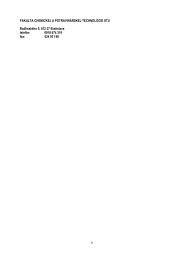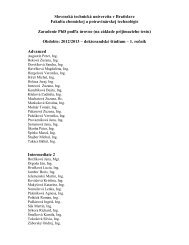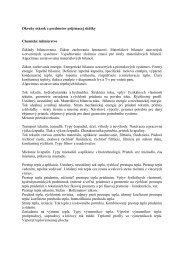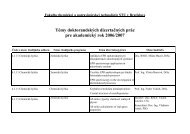rok 2006 - Fakulta chemickej a potravinárskej technológie ...
rok 2006 - Fakulta chemickej a potravinárskej technológie ...
rok 2006 - Fakulta chemickej a potravinárskej technológie ...
You also want an ePaper? Increase the reach of your titles
YUMPU automatically turns print PDFs into web optimized ePapers that Google loves.
3. semester (MSc) Risk Properties of Substances 2/0/0 Prousek,<br />
Elimination and Utilization of Wastes 2/0/0 Piatrik, Koprda<br />
Environmental Technological Project 2/1/0 Drtil, Derco<br />
Environmental Impact Assessment 2/0/0 Piatrik, Koprda<br />
Laboratory Practice III. 0/0/10 Drtil, Harangozó, Čík<br />
Control of Environmental Pollution 2/0/0 Harangozó<br />
Special Ecology and Ecotoxicology 2/0/0 Prousek<br />
Processes and Technology of Water Treatment 2/1/0 Hutňan, Bodík<br />
Air Protection Technology and Air Treatment 2/1/0 Čík<br />
Diploma Work 0/0/30 all members of the staff<br />
IV. CURRENT RESEARCH PROJECTS<br />
Part of the VEGA project No. 1/1379/04 Syntheses directed towards novel heterocyclic<br />
compounds with optoelectronic properties, specific biological activity and apoptosis (Gabriel<br />
Čík)<br />
A new type of copolymer of alkylated oligomeric thiophene and polyethylene oxide was synthesized. The<br />
copolymer is soluble in common organic solvents and in solid state, which creates structurally-organized clusters<br />
composed of conducting (oligothiophenic) and non-conducting (PEO) segments. Separated thiophenic phase was<br />
confirmed by TEM, and localised fluorescence of the thiophenic clusters.<br />
A new heterogenous photocatalyst was prepared by oxidative polymerization of the thiophene in the ZSM-5<br />
zeolite type. The polythiophene absorb radiation in the visible range of the spectrum and by illumination with<br />
visible light generates reactive oxygen species (ROS) in water medium. Efficiency of the photocatalyst was tested<br />
on the killing of Gram-positive bacteria Staphylococcus aureus and Gram negative bacteria Escherichia coli.<br />
Project duration: from 01.01.2004 to 31.12.<strong>2006</strong><br />
VEGA project No. 1/1381/04 The study of separation and isolation of metals and radionuclides<br />
from environmental components by natural and chemically modified sorbents (Vasil Koprda)<br />
This project is focussed to select natural and modified sorbents having the best (structural, mechanical, physicochemical<br />
and sorption) properties for waste water treatment, reduction of concentration of metals and<br />
radionuclides in waste waters and for a casual use as barriers against water or soil contamination at ecological<br />
incidents.<br />
The project is aimed to research properties of ion exchangers and their modifications to improve removal,<br />
especially kations of heavy metals and radionuclides at waste water treatment. Concerning the high dose<br />
equivalents of Pb 210 in human bones, the project is focussed as well for optimalisation of this heavy metal<br />
determination in mineral waters to assure the human limit of effective dose. The possibilities to affect<br />
transdermal penetration of radionuclides and/or tracer substances and their bioavailability are evaluated . The<br />
subject of the project is also the study of possibilities of limitation of effects at toxic wastes treatment in connection<br />
with introduction and improvment of the environmental management system.<br />
Project duration: from 01.12.2004 to 31.12.<strong>2006</strong><br />
VEGA project No. 2/5051/25 The effects of antioxidants and substances affecting imunity<br />
system studied in vivo on model of adjuvant arthritis (Principal reasearcher Katarína<br />
Bauerová - IEP SAS, Vice-principal researcher for FChFT - Vasil Koprda)<br />
The aim of the project is to research possibilities to influence a transport of drugs, drug and diagnostic substances<br />
through the skin and its components. In the case of harmfull contaminants to search the possibilities of increasing<br />
the penetration barriers, and in the case of drugs to find out possibilities how to enhance the process of<br />
penetration. For this sake use both, in vitro and in vivo models. To define the share of transepidermal and<br />
transfolicular penetration. To study of markers transport across synthetic biomembranes.<br />
In this project, using animal model of 5- and 9-day skin of new-born rat, model of human forearm and synthetic<br />
biomembranes of different composition, the transdermal and transfollicular transport of drugs, drug substances ,<br />
radioactive markers and biogene substances across the skin and its components is researched. The possibilities<br />
to influence the penetration barriers are determined<br />
Project duration: from 01.01.2005 to 31.12.2007<br />
112



